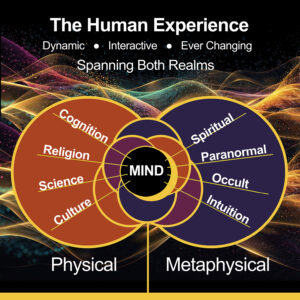In that article (The Meta Swirl: A Framework for Answering Life’s Big Questions), we established that reality, or our perception of it, is not a singular, static phenomenon but a multifaceted, ever-changing process wherein humans shape their existence through the dynamic interplay of experiences, perceptions, and thoughts, spanning both the physical and metaphysical realms.
Turning now to our everyday reality, let’s dig into how the Meta Swirl framework can help us answer our big-picture questions about life in the here and now.
The Immersive Universe
Let’s start by revisiting the idea that our dance of life unfolds within the context of an immersive universe, where both the physical and metaphysical realms of existence interact with and affect one another.
The immersive universe encompasses all aspects of existence, including energy, matter, and consciousness. It embodies the source of everything in both a progressive and destructive process of ending, renewal, creation, and transformation, continually morphing from one state to another, perpetually giving rise to new possibilities and realities.
It is not just a backdrop to our existence but an all-encompassing, dynamic environment in which we are deeply engaged and interconnected. The immersive universe is not beyond us nor separate. It’s not like we’re the audience merely viewing a movie on the big screen. It’s more like we’re active participants in an interactive play, where we affect the actors, and they, in turn, affect us.
A Construct of Our Own Making

Here’s where things start to get a bit more practical insofar as our day-to-day lives are concerned.
But first, before we delve into the specifics, the overarching point to bear in mind is that within the context of this larger, immersive universe in which we exist, the human experience is a construct of our own making.
We weave the tapestry of reality we perceive based on the dynamic interplay and filtering of energy created by our thoughts and perceptions.
The energy that gathers momentum due to its attraction to similar energy from wherever it may manifest within the domain of our existence clusters into chunks of relationships. Our mind processes these relationships and weaves them into the tapestry of reality we then perceive.
Given that everything within the immersive universe is constantly in play, interactive, and reformulating itself, our perceptions of reality, as well, are continually in a state of flux.
Shown here are some of the key constructs that we’ve woven, which shape our worldviews and guide our everyday lives, the topic we’ll turn to now.
CONTINUE HERE First of all, I’m not suggesting that we’re not physical. We may be living in an illusion, as some scientists have speculated. But even if we are, we still envision ourselves as physical beings. So, the idea that we are both physical and spiritual might be a bit of a stretch. But hold on for a bit if you’re inclined to make that kind of judgment.
From a physical perspective, we think of ourselves as having a body that walks around on the planet and does things. Mainly these things are related to our survival and comfort. We also think of ourselves as having a brain that can solve problems and which can reflect on itself.
Our preoccupation with the various components of our physical bodies is nowhere more apparent than our obsession with the Western approach to healthcare, with its focus on fixing whatever ails you primarily by physical means.
But we also seem to have hardwired in us, though in ways we don’t yet fully understand, the ability to immerse ourselves within a realm beyond the physical—a realm where intuition emerges, where mystical experiences happen, where near-death experiences manifest, where we may encounter spiritual beings, and where esoteric wisdom can pour forth to those who look deep enough for it.
++++++++++++++++++++++++
The Physical Realm
Here’s where things start to get more practical, insofar as our day to day lives are concerned.
Humans have to survive within the physical realm. Hence, our basic biological and cognitive abilities prepare us to operate within and keep us focused on what’s necessary to survive as physical beings. While a multitude of characteristically human factors help us in this regard, here are a few that are key.
- Cognitive Abilities: Our brains are intricately hard-wired to help us navigate, survive, and thrive within the physical realm. For instance, it integrates sensory inputs from various sources to create a cohesive understanding of our surroundings. It also sends signals to our muscles, enabling functions such as eating, walking, and speaking. Regarding the metaphysical, it allows us to consider what more there may be to life beyond that which lies within the same physical realm as ourselves.
- Cultural Context: Cultural context, encompassing traditions, norms, and societal values, significantly influences how we interpret and interact with our environment and one another. It also influences, to a considerable extent, our religious and spiritual leanings. Practices in Hinduism, Buddhism, Christianity, Judaism, and Islam, for instance, are all infused with our cultural conditioning. Even though there may only be one truth or one true God, our cultural upbringing paints that true God using the palette belonging to each cultural tradition.
- Scientific Inquiries: Science is pivotal in refining our understanding of ourselves and the environment within which we live. It uses empirical research and objective data to uncover our world’s underlying principles, evolves based on its findings, and opens new doors through which our adventure in life continues to unfold. The natural sciences, which have to do with the study of our physical condition, and the social sciences, which have to do with our human interactions and social structures, are equally important.
- Philosophical Pursuits: Philosophy challenges us to explore fundamental questions about existence, knowledge, and ethics. Philosophical views such as existentialism, realism, and idealism all contribute to a deeper interpretation of our experiences and beliefs. Our philosophical pursuits are not distinct from our scientific inquiries, cultural context, and cognitive abilities but are intricately linked to and influenced by all of these.
The Metaphysical Realm
Though our sense organs are actively at work, doing what they’re supposed to do in filtering out our perceptions of the metaphysical, we know, in our innermost selves, that there’s more to life than that which we can see, hear, touch, taste, and smell. Humans are greatly influenced, in fact, by that for which we have no logical explanations. Chief among those factors are the following.
- Spirituality: Spirituality fosters a sense of connection to something greater than oneself and often involves a personal journey searching for the divine. Unlike religion, which requires adherence to specific doctrines or dogma, spirituality encourages a deeper engagement with the complexities of existence and a direct experience of the sacred.
- Religion: Religion provides a structured framework for exploring the metaphysical realm, offering doctrines, rituals, and community practices that connect individuals with transcendent truths and higher powers. It encompasses diverse belief systems and practices, such as those found in Hinduism, Buddhism, Christianity, Judaism, and Islam, which offer unique spiritual perspectives and foster a sense of belonging and purpose.
- Paranormal: The term paranormal refers to the broad range of inexplicable phenomena that cannot readily be explained by any mainstream science or normal scope of understanding. Our physical sense organs can’t perceive this type of phenomenon, and it’s sometimes said that they come through to us via our sixth sense. Examples include clairvoyance, precognition, near-death experiences, intuitive flashes, and gut feelings.
Conclusion
The concept of the Meta Swirl provides a comprehensive framework for understanding the dynamic interplay of the physical and metaphysical realms in shaping human experience. It underscores reality’s interconnected, ever-evolving nature and suggests that our perception of life is not static but a multifaceted, continuously changing tapestry.
By integrating insights from both the physical and metaphysical realms, the Meta Swirl offers a holistic approach to answering life’s big questions, recognizing that understanding often lies at the intersection of empirical evidence and spiritual wisdom.
The Meta Swirl perspective encourages us to embrace the seamless interaction of all aspects of existence, acknowledging our role in co-creating reality through conscious intention and action. As part of the vast, interconnected, immersive universe acknowledged by the Meta Swirl, we are not merely observers but active participants in the swirling dance of life.




